The Magic of Large Format Cinema |
Read more at in70mm.com The 70mm Newsletter |
| Written and photographed by: Mark Trompeteler | Date: 01.04.2016 |
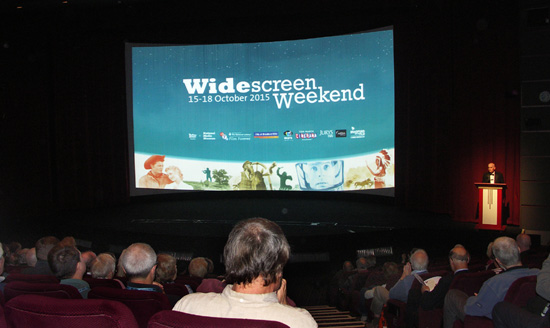 Duncan
McGregor welcoming the audience. Duncan
McGregor welcoming the audience. The UK National Media Museum’s (NMM) annual Widescreen Weekend (WSW) event in Bradford is an important international event in the area of cinema exhibition, cinema technology and popular culture. The 2015 event, one of the most successful and best attended of them, very nearly did not happen. The Museum had announced in the previous year that it would not be holding any of its regular film festivals in 2015 as it was undertaking a review of its film festivals. Given the time that this particular event had spent over the years building up an international audience, that travelled from all over the world to attend it, and the real concern that if it broke the pattern by not holding the event for a year, it would begin to start losing that audience - the reader may not be surprised to learn that BKSTS, like others, made representations to the Museum to review its decision. The suspicion too, of WSW regulars for many years, has been that this event has the potential to be one of the more financially viable, or even potentially profitable, of the various festivals that NMM holds. I think many cinema exhibition professionals and enthusiasts were delighted to hear the news, early last year, that the Museum had secured funding from the BFI and other sources and WSW 2015 would be held 15th. – 18th. October. The weekend consisted of a programme of older classic large format films, a few more contemporary ones, a screening again of short films by emerging talent, and a really great line up of speakers. |
More in 70mm reading: Widescreen Weekend 2015 / Widescreen 2016 Widescreen Weekend, Bradford, England Internet link: |
A Great Start |
|
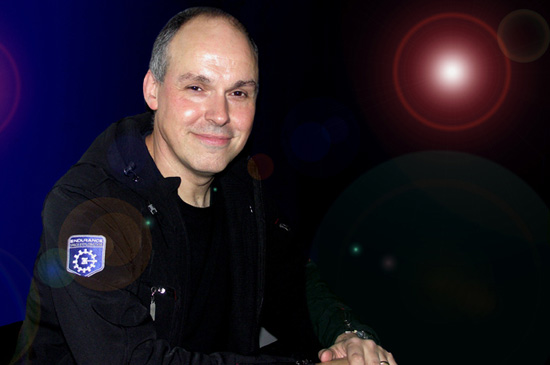 Double
Oscar Winner (VFX) Paul
Franklin talked about his work on the visual effects of “Interstellar”. Double
Oscar Winner (VFX) Paul
Franklin talked about his work on the visual effects of “Interstellar”.The weekend got off to a great start with a wine and buffet reception in the Kodak Gallery. After formal welcome speeches delivered from the lectern in the Pictureville cinema, a stylish widescreen weekend clip compilation brilliantly cut to music was screened. Edited by Tom Perkin this was a repeat of the effective kind of “curtain raiser” start to the weekend we had in the previous year. The opening night film was the musical “Oklahoma” which was part of the weekend’s celebration of the 60th. Anniversary of the Todd-AO process. What was presented was a recent restoration on a 4K DCP projected at 30fps. The steadiness and crispness of image on screen coupled together with the beauty of both those amazing vibrant colours that often form the palette of classic Hollywood musicals, together with the ability to show delicate colour, made it an exquisite presentation. A classic Hollywood film originated on celluloid and presented in pristine 4K makes for an effective combination of film and digital technologies. A combination that may be coming into favour with some current film makers – Sam Mendes “Spectre”, J.J. Abrams “Star Wars – The Force Awakens”. The following morning featured an impressive WSW item. Talking of contemporary film makers not shy of exploring the possibilities of originating on film and exhibition in digital or film – Christopher Nolan is another. His “Interstellar” was re-scheduled for a prompt 09:45 “lift off” from a 70mm print in 2:20 and dts sound. The contrasting of a contemporary large format film like this against “Oklahoma” the previous night was an inspired piece of programming. It was made particularly exciting by the arrival of Paul Franklin immediately after the screening to talk about his work on the visual effects of “Interstellar”. Double VFX Academy Award winner Franklin (“Inception”, “Interstellar”) gave an enjoyable, informative and beautifully illustrated talk about his VFX work on the film. Starting by reminding us in amusing ways of the difference between special effects and visual effects he talked us through some of the challenges, joys and satisfactions of the VFX work he oversees and gave us a real insight into his craft. After lunch I was on stage introducing a shortlist chosen from 65 entries we had received this year for the “BKSTS/NMM Student Widescreen Film of the Year” competition – the second year that BKSTS & NMM had run this competition. Following on from a double Academy Award winner, and with another Oscar winner, Douglas Trumbull, in the international audience, and following on from “Interstellar”, there was absolutely no pressure on the student work or the students present in the audience. The students’ films looked very good on the big screen and audience members including Douglas Trumbull, who came up to me after the screening, and who also spoke to the students, all commented on the very high quality of the short student widescreen films. The overall winner was “Maya” winning a camera from Black Magic Design. |
|
Smell-O-Vision |
|
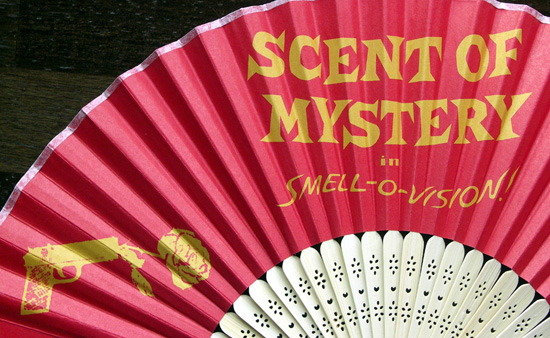 The sheer variety of items continued with a 5pm screening in
Smell-O-Vision. A team prepared the auditorium for the
Smell-O-Vision
presentation. This consisted of a number of small portable boxed fans at
the front under the screen that at certain points in the film would blow
aromas into the auditorium. There were also a large number of duplicate
numbered push down spray phials of liquid scents distributed on all the
seats across the auditorium and a set of numbered cue cards for two
assistants to use either side of the screen. By today’s standards, not
exactly the most engaging of thrillers,
“Holiday in Spain” aka
“Scent of Mystery” was originally designed and released under the
“Scent” title to be the next cinematic experience to excite audiences.
However it seemed to have been a disappointment and was re-edited and
then released under a de-odorised “Holiday” title, exploiting its
travelogue aspects, for Cinerama theatres. As part of Dave Strohmaier’s
work in the restoration of the Cinerama back catalogue he had recently
restored this film. It was both a 55th. Anniversary screening and a
world premiere for this restoration. Both Dave and Saskia Wilson-Brown,
Director of the Institute of Art & Olfaction, introduced the film. The sheer variety of items continued with a 5pm screening in
Smell-O-Vision. A team prepared the auditorium for the
Smell-O-Vision
presentation. This consisted of a number of small portable boxed fans at
the front under the screen that at certain points in the film would blow
aromas into the auditorium. There were also a large number of duplicate
numbered push down spray phials of liquid scents distributed on all the
seats across the auditorium and a set of numbered cue cards for two
assistants to use either side of the screen. By today’s standards, not
exactly the most engaging of thrillers,
“Holiday in Spain” aka
“Scent of Mystery” was originally designed and released under the
“Scent” title to be the next cinematic experience to excite audiences.
However it seemed to have been a disappointment and was re-edited and
then released under a de-odorised “Holiday” title, exploiting its
travelogue aspects, for Cinerama theatres. As part of Dave Strohmaier’s
work in the restoration of the Cinerama back catalogue he had recently
restored this film. It was both a 55th. Anniversary screening and a
world premiere for this restoration. Both Dave and Saskia Wilson-Brown,
Director of the Institute of Art & Olfaction, introduced the film. As the film screened some actors interacted with the film at certain points and at other set points in the film the front fans blew aromas into the audience. At other times when numbered cards were held up, if you had that number phial, you held it up above your head, depressed the spray button and sprayed the scent to yourself and your immediate surrounding audience members. Every audience member was also equipped with a paper fan to help both distribute aromas and help cleanse the area around your face and nostrils in between scents. I was number 7 – sherry – which whilst useful during the film when a runaway cask of the fortified wine split open – did not impress my companions late at night back in the hotel bar. Just before all of us adjourned for bed I offered to treat them all to a glass of sherry as a nightcap. As I reached into my pocket for what they thought was my wallet, they were far from impressed as I suddenly produced my phial and sprayed the definite scent of sherry above our heads, that part of the bar definitely became a sherry area for a while. Comments of audience colleagues near me about the screening were mixed – one particular point was that the cue points should be carefully considered to be a little before the scent is required. There is a definite possibility of scent synchronisation issues with Smell-O-Vision. If a number was to be held up at the exact moment the sherry cask splits open then by the time the spray is made and the scent hits the nostrils the shots in the film have moved on. Also there is a definite case for Surround Scent as audience members towards the front of the auditorium could pick up on the scents from the front boxed fans whilst those in the middle and at the back received little or no scent from these. As well as Surround Scent should Dolby be working on Scent Reduction? A fascinating piece of cinema history - once gain a memorable item experienced at WSW. |
|
Growing A New Audience |
|
|
Other classic screenings during the weekend included “Fiddler on the
Roof (2K DCP), “A Bridge Too Far" (70mm 2:20), “Gigi”
(35mm 2.35:1) and “The Magnificent Seven” (35mm 2.35:1). Dr.
Pasquale Iannone from the University of Edinburgh gave an interesting
talk on the aesthetics of widescreen composition. The exceptional nature
of the museum, and the Pictureville cinema, as a film destination, was
exploited by a three strip Cinerama screening on the Saturday night of
“How The West Was Won” (HTWWW). It was extremely pleasing to see
how many of the screenings seemed to be full houses or were near to
being full houses – when local members of the public come in to fill the
seats not purchased by the weekend delegates. It was amazing to see so
many people coming in to see “HTWWW” – perhaps boosted by a
recent preceding screening on British TV. A student I spoke to the
preceding day said he had noticed the word Cinerama on a poster in the
museum and told me he had read about the process in cinema history
books. He was totally amazed that the following day the museum was
screening a film in three strip – he had no idea there was a facility
still capable of doing so. Dave Strohmaier & Randy Gitsch introduced
their recent digital restoration of
“The Best of Cinerama” which
was presented from a 2K DCP in Smilebox on the curved screen to a
pleasantly large audience, again many members of the local public
joining delegates. After one screening of a film on the curved screen I
did overhear a patron ask a question of one of the weekend team. She
said that whilst she had enjoyed the screening of the restored film on
the deeply curved louvered screen, and she was not making a complaint,
she was just a little surprised that in the restoration process they had
not got rid of all the very feint vertical scratches that seemed to run
all the way through the film and across its full width. Again it was
pleasing to see many newcomers attending this year’s various events and
learning about lines and louvered screens and other aspects of large
format and widescreen cinema. Of the total of 3,331 attendees during the
weekend, 64% were non delegate pass holders, 46% were attending their
first WSW and 42% of weekend attendees were under the age of 45, 23%
being female and 10% of attendees were aged 16-24. |
|
Douglas Trumbull |
|
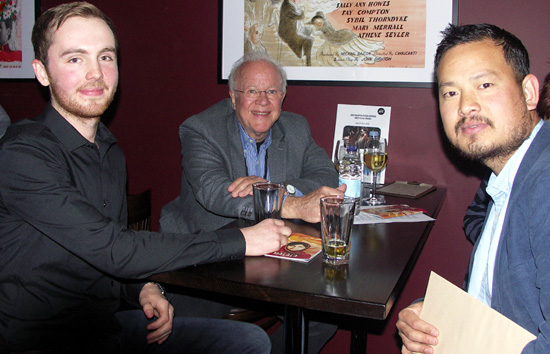 Douglas
Trumbull & Winning Student Widescreen Film Makers Douglas
Trumbull & Winning Student Widescreen Film MakersAnother item that made a major contribution to the success of the weekend was the introduction of a keynote address. The attendance of Douglas Trumbull this year both to give that address and introduce a screening of “2001” in 70mm on the curve, was something that particularly pleased delegates. In addition Douglas also introduced a screening of his film “Silent Running”. Douglas Trumbull was the ideal person to give an address entitled “The State of the Cinema”. His relevant expertise, experience and international reputation on both the engineering and technology side of cinema and cinema exhibition, and on the technology of cinematography and the creative production side as a film maker, makes him such a relevant expert to deliver such an address. His address was detailed, thorough and richly illustrated and took the audience through the beginnings of basic cinema technology, through its various stages of developments through to what he believes cinema is capable of now and in the immediate future. He led us though his argument towards the benefits and possibilities of a kind of communal virtual reality experience that can be created by using bright projection, 4K, 3D and a high frame rate of 120fps. At the end of his address he demonstrated his thesis by showing us his recent short film “UFOTOG”. Whist the luminance levels of the projection set up did not do his 3D film full justice and the subject of his film tends to be a little dark, what he showed us was impressive. I was stunned by the clarity and realism that the 120 fps rate added to the visual experience. The clarity of the image and the absence of any image artefacts somehow made me lose any consciousness of the fact that I was looking at an image on a screen – it appeared to me as though the actor was looking directly at me as if through an open window and I was looking directly back at him and no screen was involved between us. I think the lighting, lens used and composition all augmented the effect. Also the effect on a screen that would totally fill my field of vision would be quite remarkable. Douglas Trumbull’s short demonstration film of his MAGI process was a real insight into what cinema technology and creativity could be capable of just by fully exploiting existing technology. Trumbull’s introductions to two excellent screenings of “Silent Running” and “2001” gave a really good insight into the two films. After the screening of “2001” Trumbull returned to the stage to be part of a question and answer session and this went on until well past midnight. His own personal photos and sketches were projected as a back drop during this session. An audience discussing “2001”, VFX and film making with Douglas Trumbull after a 70 mm screening on the curve of the film, until well after midnight, is a film festival experience that just doesn’t get any better. |
|
Another Great Weekend |
|
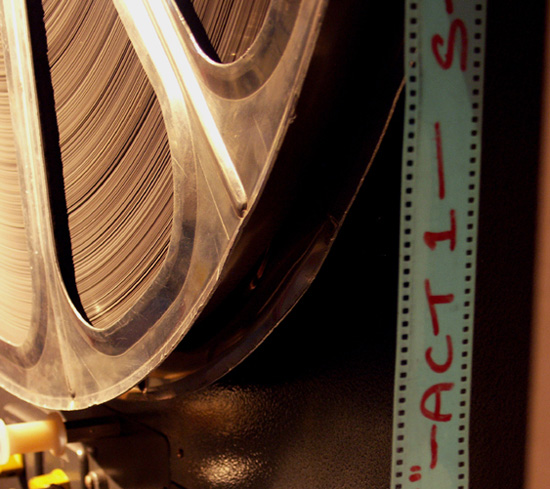 The contribution of
Bill Lawrence in developing the WSW event over the
years, then Thomas Hauerslev, and now Duncan McGregor in further
developing it and ensuring its continuation in 2015, cannot be
underestimated. There has been an impact caused by public expenditure
cutbacks, restructuring, reductions in staffing and outsourcing of
functions to commercial companies in major national institutions such as
The Science Museum Group, of which NMM is a part, the British Film
Institute, and other major cultural institutions within the UK. As I
attended the weekend and saw the amount of work that was being done in
such a stringent financial climate to provide a fabulous weekend, I
couldn’t help thinking that if it wasn’t for the superhuman efforts of
Duncan McGregor, curator of this weekend, it would not have happened and
achieved the success that it did. Duncan was again assisted this year by
dedicated PictureHouse projectionists and employees, museum colleagues,
contributors and volunteers and this year’s guest curator, the ever
popular and authoritative Sir Christopher Fraying. Congratulations to
the Museum, the Picturehouse Group and the teams within both
organisations, but especially Duncan McGregor for delivering such a
great weekend. The contribution of
Bill Lawrence in developing the WSW event over the
years, then Thomas Hauerslev, and now Duncan McGregor in further
developing it and ensuring its continuation in 2015, cannot be
underestimated. There has been an impact caused by public expenditure
cutbacks, restructuring, reductions in staffing and outsourcing of
functions to commercial companies in major national institutions such as
The Science Museum Group, of which NMM is a part, the British Film
Institute, and other major cultural institutions within the UK. As I
attended the weekend and saw the amount of work that was being done in
such a stringent financial climate to provide a fabulous weekend, I
couldn’t help thinking that if it wasn’t for the superhuman efforts of
Duncan McGregor, curator of this weekend, it would not have happened and
achieved the success that it did. Duncan was again assisted this year by
dedicated PictureHouse projectionists and employees, museum colleagues,
contributors and volunteers and this year’s guest curator, the ever
popular and authoritative Sir Christopher Fraying. Congratulations to
the Museum, the Picturehouse Group and the teams within both
organisations, but especially Duncan McGregor for delivering such a
great weekend. |
|
| Go: back - top - back issues - news index Updated 22-01-25 |
